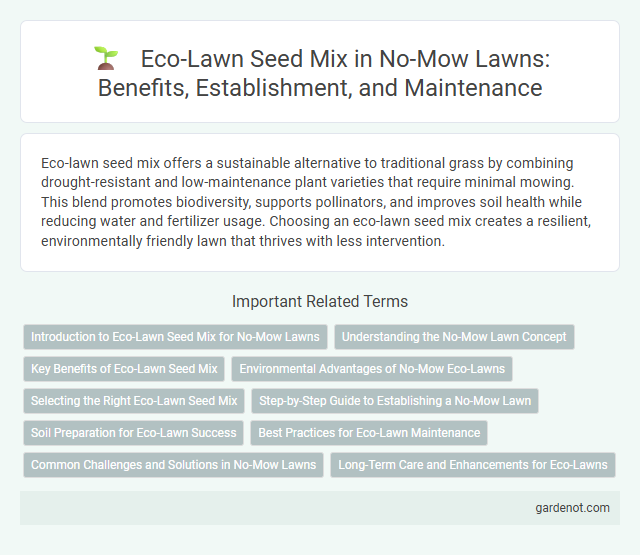Eco-lawn seed mix offers a sustainable alternative to traditional grass by combining drought-resistant and low-maintenance plant varieties that require minimal mowing. This blend promotes biodiversity, supports pollinators, and improves soil health while reducing water and fertilizer usage. Choosing an eco-lawn seed mix creates a resilient, environmentally friendly lawn that thrives with less intervention.
Introduction to Eco-Lawn Seed Mix for No-Mow Lawns
Eco-lawn seed mix combines low-growing grass species and clover varieties tailored for no-mow lawns, promoting minimal maintenance and sustainable landscaping. This specialized blend enhances soil health, supports biodiversity, and reduces water consumption compared to traditional turfgrass. Selecting the right eco-lawn seed mix ensures a resilient, drought-tolerant lawn that thrives with minimal mowing and fertilizing.
Understanding the No-Mow Lawn Concept
Eco-lawn seed mixes feature drought-tolerant, low-maintenance grass varieties such as fine fescues and clover, designed to thrive with minimal mowing and watering. These blends promote biodiversity, reduce lawn-care emissions, and improve soil health by fostering natural growth cycles and deeper root systems. Embracing a no-mow lawn with eco-lawn seeds lowers maintenance costs while supporting sustainable landscaping practices.
Key Benefits of Eco-Lawn Seed Mix
Eco-lawn seed mix promotes drought resistance and requires significantly less water than traditional grass, reducing maintenance and environmental impact. Its low-growth nature minimizes the need for mowing, saving time and lowering fuel consumption from lawn equipment. The blend often includes native species that enhance biodiversity and improve soil health, contributing to a sustainable and eco-friendly lawn solution.
Environmental Advantages of No-Mow Eco-Lawns
No-mow eco-lawn seed mixes significantly reduce water consumption and lower carbon emissions by eliminating the need for frequent mowing. These seed blends promote biodiversity by supporting pollinators and beneficial insects, fostering a healthier ecosystem. Their deep-rooted grasses improve soil structure and enhance carbon sequestration, contributing to long-term environmental sustainability.
Selecting the Right Eco-Lawn Seed Mix
Selecting the right eco-lawn seed mix involves choosing drought-tolerant, low-maintenance grass species such as fine fescues, buffalo grass, and clover that thrive without frequent mowing. Prioritize blends designed to improve soil health, enhance biodiversity, and reduce water usage, ensuring sustainable lawn growth. Consider local climate conditions and soil types to optimize seed germination and achieve a resilient, eco-friendly lawn.
Step-by-Step Guide to Establishing a No-Mow Lawn
Select a high-quality eco-lawn seed mix containing drought-tolerant, low-growing grasses such as fine fescues and clover to reduce mowing frequency. Prepare the soil by removing existing grass and debris, then loosen the topsoil to promote seed germination and root establishment. Sow the seeds evenly, lightly rake to cover them, and water consistently until the eco-lawn develops a dense, resilient cover that thrives with minimal maintenance.
Soil Preparation for Eco-Lawn Success
Proper soil preparation is essential for successful Eco-lawn seed mix establishment, requiring thorough loosening and leveling of the soil to enhance seed-to-soil contact. Removing debris and weeds while ensuring adequate drainage prevents competition and promotes healthy root development. Incorporating organic matter improves soil fertility and moisture retention, creating optimal conditions for Eco-lawn growth and sustainability.
Best Practices for Eco-Lawn Maintenance
Eco-lawn seed mixes thrive with minimal mowing, promoting biodiversity and reducing water use. Regularly mowing at a higher setting of 3 to 4 inches preserves beneficial grasses while suppressing weeds. Seasonal irrigation and avoiding over-fertilization maintain soil health and vibrant growth in eco-lawn landscapes.
Common Challenges and Solutions in No-Mow Lawns
Common challenges in no-mow lawns with Eco-lawn seed mix include uneven germination and weed invasion due to varying soil conditions. Solutions involve improving soil preparation through aeration and balanced fertilization, alongside regular mulching to retain moisture and suppress weeds. Selecting drought-tolerant and shade-resistant grass varieties within the Eco-lawn mix enhances resilience and reduces maintenance needs.
Long-Term Care and Enhancements for Eco-Lawns
Eco-lawn seed mixes require minimal mowing, promoting drought resistance and biodiversity while reducing maintenance costs over time. Incorporating native grasses and clover species enhances soil health, improves nitrogen fixation, and supports pollinators essential for long-term ecosystem balance. Regular overseeding with eco-friendly seed blends and seasonal nutrient updates sustain lawn density and resilience against pests and environmental stress.
Eco-lawn seed mix Infographic

 gardenot.com
gardenot.com